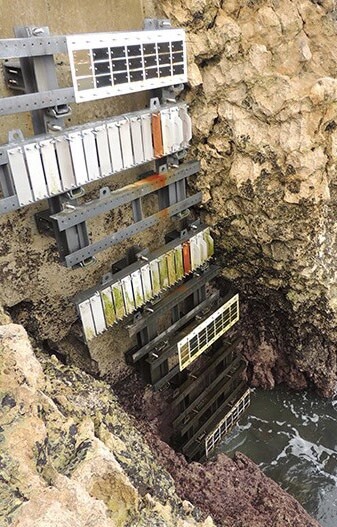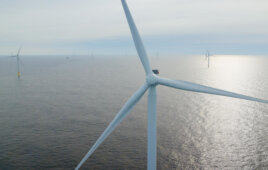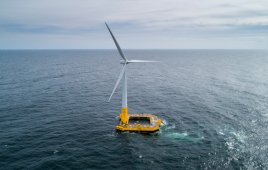John Kosowatz, Senior Editor, ASME.org
It is standard practice to use specialized coatings and paint to protect machinery and infrastructure from harsh conditions. But researchers are making steady progress in improving their effectiveness, using advanced manufacturing techniques and salting the coatings with smart particles for self-healing.
A European Union-funded research and development project has passed to the commercial stage, relying on thermally sprayed aluminum spiked with environmentally friendly, active antifouling substances to protect offshore steel renewable energy structures. The chemicals are added in small amounts. As the protective TSA eventually degrades, an insoluble calcareous material is formed to fortify the breach and provide protection.

The coupons are part of a corrosion and fouling test at a facility near Santander, Spain. Photo: The Welding Institute
Corrosion and fouling test facility near Santander, Spain. Image: The Welding Institute
Dubbed ACORN, for Advanced Coating for Offshore Renewable Energy, the effort also includes developing a new coating to prevent cavitation erosion of marine turbine components. After testing three types of coatings, researchers found that a cermet HVOF [high-velocity oxygen fuel] coating offered corrosion and cavitation protection good for a 10-plus year design life.
In the US, the NASA Kennedy Space Center’s Corrosion Technology Laboratory has developed a smart, environmentally friendly coating for early detection and inhibition of corrosion that also has self-healing properties. It uses microcapsules formed through an interfacial polymerization process; one type of microcapsule contains a corrosion inhibitor and another contains an indicator. When corrosion begins, the microcapsules react to the change in pH levels and the inhibitor is released, forming a film that protects and repairs the affected area. The indicator identifies the affected area with a change of color. NASA officials say the new coating poses no threat to the environment, an improvement on existing compounds.
NASA researchers developed the coating because the sun, heat, and humidity of the Kennedy Space Complex’s location in south Florida makes it the country’s most corrosive environment, according to the American Society of Metals. The space shuttle program amplified the problem in the 1980s because of acidic exhaust from solid rocket boosters.
The U.S. Navy also is conducting research to replace hexavalent chromium with smart coatings. The work focuses on conductive polymers that form metal oxide films around the affected area. They form a dense, low-porosity film that restricts invasion of oxidants. The Navy already has developed a polymer that is a derivative of polyparaphenylene vinylene that shows promise for replacing hexavalent chromium treatment on aluminum alloys.
In Europe, EU researchers worked with thermally sprayed aluminum, already recognized as an effective coating for a variety of applications. As offshore wind power grows in European waters—12,631 MW were already installed at the beginning of 2017 and another 3,000 MW are expected by 2020, according to Brussels-based Wind Europe—planners recognized the need for better protecting the foundations as well as the turbines.
For the rest of the article: http://www.asme.org/engineering-topics/articles/energy/smart-coatings-mean-longer-offshore-life
Filed Under: Offshore wind




